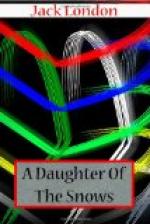As to Vance Corliss. First, and most necessary of all, there was that physiological affinity between them that made the touch of his hand a pleasure to her. Though souls may rush together, if body cannot endure body, happiness is reared on sand and the structure will be ever unstable and tottery. Next, Corliss had the physical potency of the hero without the grossness of the brute. His muscular development was more qualitative than quantitative, and it is the qualitative development which gives rise to beauty of form. A giant need not be proportioned in the mould; nor a thew be symmetrical to be massive.
And finally,—none the less necessary but still finally,—Vance Corliss was neither spiritually dead nor decadent. He affected her as fresh and wholesome and strong, as reared above the soil but not scorning the soil. Of course, none of this she reasoned out otherwise than by subconscious processes. Her conclusions were feelings, not thoughts.
Though they quarrelled and disagreed on innumerable things, deep down, underlying all, there was a permanent unity. She liked him for a certain stern soberness that was his, and for his saving grace of humor. Seriousness and banter were not incompatible. She liked him for his gallantry, made to work with and not for display. She liked the spirit of his offer at Happy Camp, when he proposed giving her an Indian guide and passage-money back to the United States. He could do as well as talk. She liked him for his outlook, for his innate liberality, which she felt to be there, somehow, no matter that often he was narrow of expression. She liked him for his mind. Though somewhat academic, somewhat tainted with latter-day scholasticism, it was still a mind which permitted him to be classed with the “Intellectuals.” He was capable of divorcing sentiment and emotion from reason. Granted that he included all the factors, he could not go wrong. And here was where she found chief fault with him,—his narrowness which precluded all the factors; his narrowness which gave the lie to the breadth she knew was really his. But she was aware that it was not an irremediable defect, and that the new life he was leading was very apt to rectify it. He was filled with culture; what he needed was a few more of life’s facts.
And she liked him for himself, which is quite different from liking the parts which went to compose him. For it is no miracle for two things, added together, to produce not only the sum of themselves, but a third thing which is not to be found in either of them. So with him. She liked him for himself, for that something which refused to stand out as a part, or a sum of parts; for that something which is the corner-stone of Faith and which has ever baffled Philosophy and Science. And further, to like, with Frona Welse, did not mean to love.




